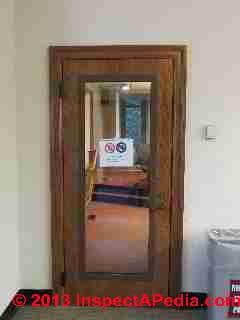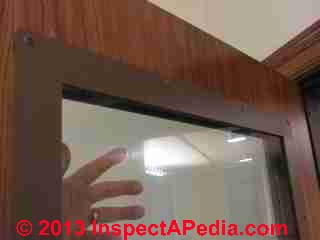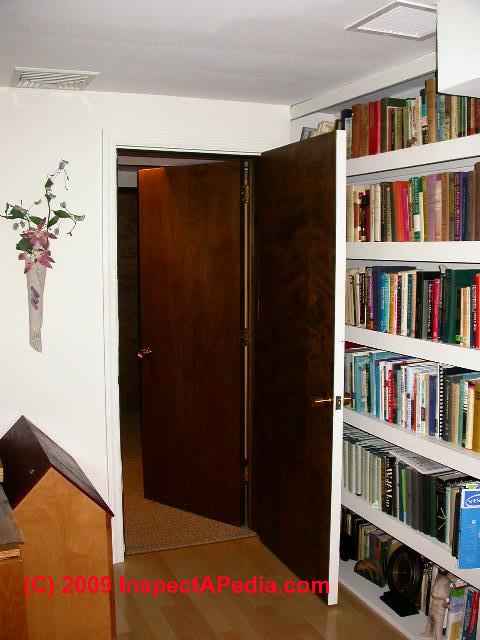 Sound Control for Doors & Doorways
Sound Control for Doors & Doorways
Flanking sound transmission at entrances & doors
- POST a QUESTION or COMMENT about how to cut down on building noise - sound control using flanking sound path interception and sound deadening techniques
Door noise or sound transmission control:
This article explains how to make sound-reducing or "soundproof" doors and doorways in buildings. A key component in noise control and sound privacy improvements is the elimination of flanking pathways at entrances or doors as well as using doors that themselves are resistant to sound transmission.
A closet door may form a sound flanking pathway, while a hollow-core entry door may readily transmit noises outside of a room, violating privacy or creating a noise nuisance.
InspectAPedia tolerates no conflicts of interest. We have no relationship with advertisers, products, or services discussed at this website.
- Daniel Friedman, Publisher/Editor/Author - See WHO ARE WE?
Design Details for Soundproof Doors & Doorways
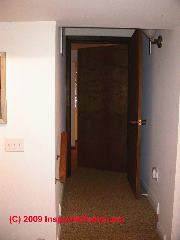 As described in Best Practices Guide to Residential Construction (Steve Bliss, J Wiley & Sons) :
As described in Best Practices Guide to Residential Construction (Steve Bliss, J Wiley & Sons) :
Soundproof double-door doorways: Upgrade to solid-core doors and add weather-stripping.
Our photo (left) shows an installation of doubled solid core doors that has been found effective in minimizing sound transmission between a counseling office and its waiting room.
Similar to the double sound-transmission resistant doorway shown at the top of this page, here the designer incorporated a short hallway between a waiting room and the counseling office.
Outside a waiting room closet, forming one wall of the entry hall, provides additional soundproofing and privacy for this space.
As we discuss below at SOUND CONTROL for WALLS, closets provide additional sound transmission buffering provided their doors are solid, not louvered.
Addressing obvious flanking paths is often the most cost-
effective step in soundproofing a home.
Strategies such as
sealing air leaks between rooms, upgrading doors, and adding
weather-stripping may provide adequate sound isolation
without the need for more exotic and expensive measures.
Soundproof single door with glass panel
Above we illustrate a sound-proof door installed on a music classroom at Vassar College. The frame of this soundproof door with its large glass center panel is filled with sound deadening materials. And as you can see in the close-up photo just below, additional steps to reduce sound transmission through the door or its jamb were taken by spacing, glass type, and sound-absorption into the door frame.
In general, sound-resistant doors should be within 10 Sound Transmission Class (STC) points of the surrounding wall. Solid-core doors are recommended for bedrooms and bathrooms.
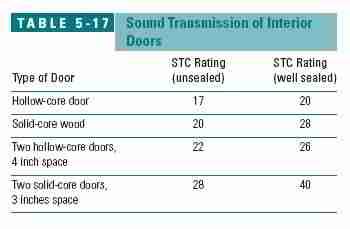 Where higher-level sound
isolation is required, you will need to add high-quality
gasket-type weather-stripping and a sealed threshold.
Where higher-level sound
isolation is required, you will need to add high-quality
gasket-type weather-stripping and a sealed threshold.
Also the gap between the door jamb and studs should be caulked or grouted to avoid sound leaks around the door.
A doubled sound transmission resistant interior door installation is shown at SOUND ABSORPTION vs. SOUND ISOLATION.
For even higher sound resistance ratings, which might be needed for a music room, for example, double doors are required (see our Table of Sound Transmission Characteristics of Interior Doors shown at left).
You can see from the table "Sound Transmission of Interior Doors" that the example in our photo above, two solid core doors spaced 3-inches apart gives the best STC rating in both unsealed and well sealed installations.
- - Adapted with permission from Best Practices Guide to Residential Construction (Steve Bliss, J Wiley & Sons) .
Building noise control - flanking pathways: this article series explains how sound flanking paths, sound leaks around and through building components, defeats incomplete attempts to reduce building sound transmission and noise levels. We include design details for sound reducing details in buildings including soundproof office doorways and doors.
...
Continue reading at SOUND CONTROL for FLOORS or select a topic from the closely-related articles below, or see the complete ARTICLE INDEX.
Or see
NOISE / SOUND DIAGNOSIS & CURE
SOUND TRANSMISSION CLASS RATINGS
SOUND CONTROL in BUILDINGS - home
WINDOWS & DOORS - home
Suggested citation for this web page
SOUND CONTROL for DOORS at InspectApedia.com - online encyclopedia of building & environmental inspection, testing, diagnosis, repair, & problem prevention advice.
Or see this
INDEX to RELATED ARTICLES: ARTICLE I NDEX to BUILDING NOISE DIAGNOSIS
Or use the SEARCH BOX found below to Ask a Question or Search InspectApedia
Ask a Question or Search InspectApedia
Questions & answers or comments about how to cut down on building noise - sound control using flanking sound path interception and sound deadening techniques.
Try the search box just below, or if you prefer, post a question or comment in the Comments box below and we will respond promptly.
Search the InspectApedia website
Note: appearance of your Comment below may be delayed: if your comment contains an image, photograph, web link, or text that looks to the software as if it might be a web link, your posting will appear after it has been approved by a moderator. Apologies for the delay.
Only one image can be added per comment but you can post as many comments, and therefore images, as you like.
You will not receive a notification when a response to your question has been posted.
Please bookmark this page to make it easy for you to check back for our response.
IF above you see "Comment Form is loading comments..." then COMMENT BOX - countable.ca / bawkbox.com IS NOT WORKING.
In any case you are welcome to send an email directly to us at InspectApedia.com at editor@inspectApedia.com
We'll reply to you directly. Please help us help you by noting, in your email, the URL of the InspectApedia page where you wanted to comment.
Citations & References
In addition to any citations in the article above, a full list is available on request.
- [1] Marpac, produces white sound generators, a product that they identify as the Marpac sound conditioner. Marpac can be contacted at http://www.marpac.com/ or contact the Marpac Corporation, P.O. Box 560 Rocky Point, NC 28457 Phone: 800-999-6962 (USA and Canada) Fax: 910-602-1435 1-910-602-1421 (worldwide), 800-999- or email: info@marpac.com
- [2] Sound Oasis sound conditioners are produced by Sound Oasis: http://www.sound-oasis.com/ email: info@sound-oasis.com or 1-866-625-3218
- Our recommended books about building & mechanical systems design, inspection, problem diagnosis, and repair, and about indoor environment and IAQ testing, diagnosis, and cleanup are at the InspectAPedia Bookstore. Also see our Book Reviews - InspectAPedia.
- Decks and Porches, the JLC Guide to, Best Practices for Outdoor Spaces, Steve Bliss (Editor), The Journal of Light Construction, Williston VT, 2010 ISBN 10: 1-928580-42-4, ISBN 13: 978-1-928580-42-3, available from Amazon.com
- In addition to citations & references found in this article, see the research citations given at the end of the related articles found at our suggested
CONTINUE READING or RECOMMENDED ARTICLES.
- Carson, Dunlop & Associates Ltd., 120 Carlton Street Suite 407, Toronto ON M5A 4K2. Tel: (416) 964-9415 1-800-268-7070 Email: info@carsondunlop.com. Alan Carson is a past president of ASHI, the American Society of Home Inspectors.
Thanks to Alan Carson and Bob Dunlop, for permission for InspectAPedia to use text excerpts from The HOME REFERENCE BOOK - the Encyclopedia of Homes and to use illustrations from The ILLUSTRATED HOME .
Carson Dunlop Associates provides extensive home inspection education and report writing material. In gratitude we provide links to tsome Carson Dunlop Associates products and services.


